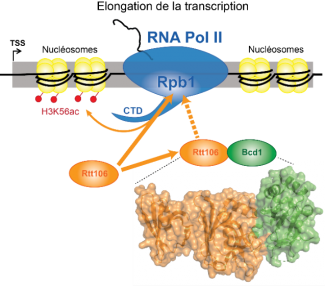
By associating with specific proteins, non-coding RNAs (ncRNAs) perform a wide variety of functions essential to cell biology. Among these ncRNAs, the small nucleolar RNAs of the so-called C/D conserved box family (C/D snoRNAs) form ribonucleoprotein particles called C/D snoRNP by associating with 4 invariable proteins. One of these proteins is a 2'-O-methyltransferase which catalyzes methylation on oxygen bound to carbon at the 2' position of the riboses of other RNAs when they specifically pair with the snoRNA included in the C/D snoRNP. For example, for ribosomes, these 2'-O-methylations are concentrated in the functional regions of ribosomal RNA and contribute to the fidelity of mRNA translation which enables the synthesis of cellular proteins.
The assembly of a snoRNP takes place on a nascent snoRNA, together with its transcription, and requires the intervention of dedicated machinery. The Nancy team RNA-RNP led by Bruno Charpentier (IMoPA, UMR7365 CNRS UL) has been carrying out structure-function studies for several years to understand the assembly molecular mechanisms of several RNA-protein cellular complexes including snoRNPs. Previous work in collaboration with the teams of Sarah Cianférani (IPHC, LSMBO, UMR7178, ProFI-Strasbourg) and Edouard Bertrand (IGH, UMR9002, Montpellier) identified the protein factors constituting the assembly machinery of the C/D snoRNPs. This machinery is composed in Saccharomyces cerevisiae of the heterodimer Rsa1:Hit1, the ATPase R2TP complex (Rvb1/2, Tah1, Pih1), the chaperone protein HSP90 as well as Bcd1.
The latest work carried out in collaboration with Dr Saveanu (GIM / IP, CNRS UMR3525) reveals genetic links between the gene encoding Rsa1 and genes involved in the control of chromatin structure. In addition, a physical link is demonstrated between the Bcd1 protein and the Rtt106 protein, which belongs to the histone chaperone family. It is an important player in the establishment of the epigenetic modification by acetylation of lysine 56 of histone H3 (H3K56ac) in S. cerevisiae. Indeed, it controls the incorporation into chromatin of H3K56ac histones during chromosome replication and chromatin remodelling associated with gene transcription. The present study shows that the association of Rtt106 with transcriptionally active DNA regions correlates with its association with RNA polymerase II which produces mRNAs and that Bcd1 controls the abundance of H3K56ac marks at several gene regions transcribed by this polymerase. The data converge on a model in which recruitment of the histone chaperone to transcription sites is limited by its interaction with Bcd1 which acts as a competitor for the association of Rtt106 with RNA polymerase II (see illustration below). The interaction between Bcd1 and Rtt106 is characterized at the molecular and atomic levels by a combination of approaches such as isothermal calorimetric titration, cross-links or H/D exchange followed by mass spectrometry (ProFI-Strasbourg), Nuclear Magnetic Resonance (UMS 2008/US40, B2S), and X-Ray Crystallography (UMS 2008/US40, B2S). The three-dimensional structure of the complex describes how Bcd1 binds to the PH1 domain (Pleckstrin-Homology 1) of Rtt106 (see illustration below).
In conclusion, the data presented provide a better understanding of how, in addition to its activity during DNA replication, the Rtt106 chaperone contributes to the remodelling of the chromatin structure during active transcription by RNA polymerase II. A new interface has been identified in its PH1 domain for interaction with Bcd1, an essential factor for the assembly of C/D snoRNPs. The Rtt106:Bcd1 interaction demonstrated here, unveils a new connection that may be important in coordinating RNA polymerase II transcription activity in ribosome biogenesis.
Publication: Bragantini B, Charron C, Bourguet M, Paul A, Tiotiu D, Rothé B, Marty H, Terral G, Hessmann S, Decourty L, Chagot ME, Strub JM, Massenet S, Bertrand E, Quinternet M, Saveanu C, Cianférani S, Labialle S, Manival X, Charpentier B. The box C/D snoRNP assembly factor Bcd1 interacts with the histone chaperone Rtt106 and controls its transcription dependent activity. Nat Commun. 2021 Mar 25;12(1):1859.
- DOI : 10.1038/s41467-021-22077-4
- PUBMED : 33767140
- HAL : HAL-03181046



